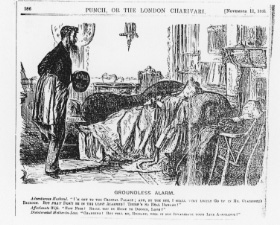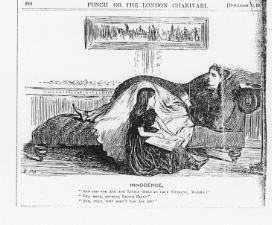
Punch,14 (November 11, 1865):186

Punch, 14 (November 17, 1866):202


 he above illustrations by George du Maurier (1834-96) depict the idealized Victorian woman as mother and wife. The numerous advancements made during the Victorian age and the ensuing challenges upon traditional moral values, made many people look to the home as a symbol of virtue. The domestic space counteracted the religious doubt and the troubling competitive business market. A man's home was his castle, where everything should work according to his desires. In this space the wife, the angel of the house, was untainted by troubles from the outside. She embodied the ideal of love, beauty, and virtue. Her characteristics also made her a passive model. Women were seen as physically and emotionally unfit to take on the rigors of life. They were not expected to move beyond the home to take part in politics or professional jobs. These beliefs were held by many in the era, including influential members of Parliament, like Samuel Smith. In 1891, Smith stated:
Women cannot undertake this [study of politics] without destroying their domestic life. A good wife and mother cannot leave her home to attend clubs and public meetings, and if she does she will soon cease to be a good wife and mother.
To become anything besides a mother and wife threatened the cherished image of the home.
Groundless Alarm and Innocence are typical of Punch's representations of women in the domestic setting. Both women are inactive as they lay down. Their youthful and simplistic features, including a small nose and forehead, compose the quintessential Victorian woman. In Innocence, the mother's attention is focused upon her daughter. She has a very serene expression on her face and does not appear to have any concerns. In Groundless Alarm, the woman looks at her husband, who has just announced is plans to go out. Even though she is apparently awake and speaking to him, she looks unconscious. In the dialogue below, the woman is described as an affectionate wife. It is an ironic title, because she couldn't care less what her husband does. Her only concern is whether he will be home for dinner. This humorous interaction suggests the wife's inability to worry about anything beyond the home. The lackluster existence of these women is seen repeatedly in the pages of Punch. The "new woman" fought the confining definition of women as strictly wives and mothers. Feminists sought a more open conception that involved female activity beyond the home. Punch's response to the movement varied. In one instance, the journal reflected skepticism about women's capabilities, while in another instance, they were supportive of the need for change.
he above illustrations by George du Maurier (1834-96) depict the idealized Victorian woman as mother and wife. The numerous advancements made during the Victorian age and the ensuing challenges upon traditional moral values, made many people look to the home as a symbol of virtue. The domestic space counteracted the religious doubt and the troubling competitive business market. A man's home was his castle, where everything should work according to his desires. In this space the wife, the angel of the house, was untainted by troubles from the outside. She embodied the ideal of love, beauty, and virtue. Her characteristics also made her a passive model. Women were seen as physically and emotionally unfit to take on the rigors of life. They were not expected to move beyond the home to take part in politics or professional jobs. These beliefs were held by many in the era, including influential members of Parliament, like Samuel Smith. In 1891, Smith stated:
Women cannot undertake this [study of politics] without destroying their domestic life. A good wife and mother cannot leave her home to attend clubs and public meetings, and if she does she will soon cease to be a good wife and mother.
To become anything besides a mother and wife threatened the cherished image of the home.
Groundless Alarm and Innocence are typical of Punch's representations of women in the domestic setting. Both women are inactive as they lay down. Their youthful and simplistic features, including a small nose and forehead, compose the quintessential Victorian woman. In Innocence, the mother's attention is focused upon her daughter. She has a very serene expression on her face and does not appear to have any concerns. In Groundless Alarm, the woman looks at her husband, who has just announced is plans to go out. Even though she is apparently awake and speaking to him, she looks unconscious. In the dialogue below, the woman is described as an affectionate wife. It is an ironic title, because she couldn't care less what her husband does. Her only concern is whether he will be home for dinner. This humorous interaction suggests the wife's inability to worry about anything beyond the home. The lackluster existence of these women is seen repeatedly in the pages of Punch. The "new woman" fought the confining definition of women as strictly wives and mothers. Feminists sought a more open conception that involved female activity beyond the home. Punch's response to the movement varied. In one instance, the journal reflected skepticism about women's capabilities, while in another instance, they were supportive of the need for change. [Victorian initial "T" by Harlan Wallach ©copyright 1994.]